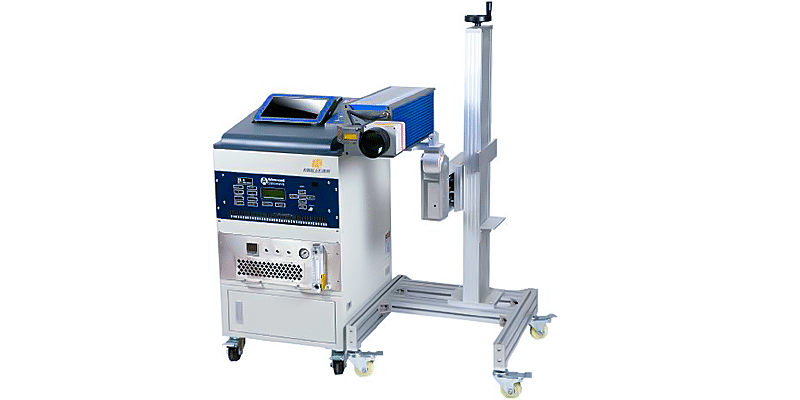A laser marking machine is a device that uses laser technology to mark information on the surface of a product or its packaging. It can accurately print text, numbers, graphics, barcodes, QR codes, and other content. Compared to traditional marking methods, laser marking offers advantages such as high speed, high clarity, and long-lasting results. It is widely used for product traceability and information identification.
Working Principle of Laser Marking Machine
A laser marking machine uses a laser beam to create permanent marks on the surface of various materials. The marking effect is achieved by using the high energy density of the laser to locally irradiate the workpiece, causing the surface material to either evaporate and expose the underlying layer, undergo a chemical or physical change due to the laser energy to "engrave" the mark, or be partially burned away to reveal the desired pattern or text.
1.Core technology
(1) Laser
Laser technology is the most important core technology in laser marking machines. With laser technology, fast marking, multiple code types, precise recognition, and time and labor savings can be achieved. Laser marking machines include red laser, blue laser, and mid-infrared lasers. They feature fast marking speed, high marking accuracy, and adjustable settings. They can quickly generate specific marking patterns on products and mark from a necessary distance, avoiding manual marking work and greatly improving work efficiency.
(2) Modulator
The laser modulator generates individual laser spots according to the limitations of the laser device, forming the laser source, and modulates the required text and code graphics. Laser marking machines usually work with modulators, whose role is to adjust the laser energy to achieve the required brightness and uniformity, ensuring the quality of the laser marking.
(3) Module
The module of the laser marking machine is the carrier for laser driving and control. It combines laser technology, modulators, and the laser head. Typically, it is square-shaped, made of metal or high-hardness plastic, and integrates a flexible mechanical displacement system along with automatic precision alignment components. It provides accurate marking positions via linear or curved movements, ensuring precise laser marking.
(4) Marking Head
Laser marking machines usually use high-precision glass lasers, including high-performance laser tubes and accurate planar lenses, which effectively ensure the laser beam quality and brightness, allowing the laser spot size and position to meet required standards and remain stable. Additionally, the marking head needs a control board equipped with a high-speed control port to control the movement of the marking head and more accurately adjust the marking effect.
2.Operation Principle
The working principle of a laser marking machine involves using the laser, modulator, module, and print head mentioned above to complete the marking process. The laser source generated by the modulator is directed to the print head, which precisely controls the laser dots and the spacing between them. The print head scans and moves to direct the laser beam, enabling accurate laser marking. Under drive control, the print head moves both horizontally and vertically, repeatedly scanning to accumulate laser marks. This forms a clear printed pattern on the surface of objects or packaging, ultimately completing the laser marking process.

3.Advantages of Using a Laser Marking Machine
The average maintenance-free lifespan of the laser source can reach up to 100,000 hours. The laser source requires almost no maintenance, causes no environmental pollution, and saves significant costs compared to traditional inkjet printing.
Laser marking provides permanent, indelible marks that are not affected by external environmental factors, helping to enhance brand recognition.
It supports various marking styles such as QR codes, barcodes, images, and text.
Helps prevent date tampering and counterfeit products.
Reduces labor costs, eliminates the need for frequent ink replacement and cleaning, ensures stable marking, and does not interrupt the normal operation of the production line.
4.Common Faults and Solutions
1. Laser coding machine fails to print: One aspect is to check whether the signal transmission is normal and whether the print counter in the control system of the laser machine is changing; on the other hand, check whether the hardware (laser head) is functioning properly.
Solution: First, check whether the photoelectric sensor is operating normally and whether the print parameter settings are correct.
2. Marking is unclear or blurry: This may be caused by incorrect focal length of the laser head, resulting in blurry marking, or due to incorrect settings of power and marking speed.
Solution: Clean the laser head, adjust the focal position, and adjust parameters such as laser marking power.
3. Incomplete printed patterns or text: This may be caused by excessively high printing speed, improper focal distance adjustment, or issues with the equipment quality.
Solution: Reduce the printing speed, adjust the focal position appropriately, and check whether the hardware configuration of the equipment can meet production requirements.

